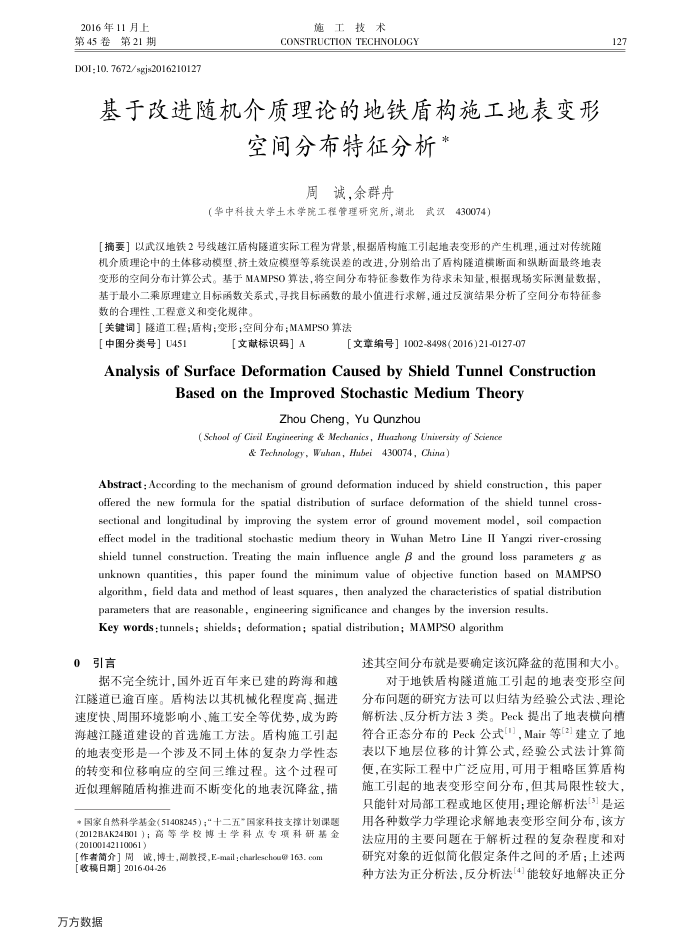基于改进随机介质理论的地铁盾构施工地表变形空间分布特征分析
内容简介
 2016年11月上第45卷第21期
2016年11月上第45卷第21期D0I:10.7672/sgjs2016210127
施工技术
CONSTRUCTION TECHNOLOGY
基于改进随机介质理论的地铁盾构施工地表变形
空间分布特征分析
周诚,余群舟
(华中科技大学土术学院工程管理研究所,湖北武汉430074)
【摘要】以武汉地铁2号线越江盾构隧道实际工程为背景,根据盾构施工引起地表变形的产生机理,通过对传统随机介质理论中的土体移动模型、挤土效应模型等系统误差的改进,分别给出了盾构隧道横断面和纵断面最终地表变形的空间分布计算公式。基于MAMPSO算法,将空间分布特征参数作为待求未知量,根据现场实际测量数据,基于最小二乘原理建立目标函数关系式,寻找目标函数的最小值进行求解,通过反演结果分析了空间分布特征参数的合理性、工程意义和变化规律。
[关键词】隧道工程;盾构;变形;空间分布;MAMPSO算法
【中图分类号]U45]
【文献标识码]A
[文章编号】1002-8498(2016)21-0127-07
AnalysisofSurfaceDeformationCausedbyShieldTunnelConstruction
BasedontheImprovedStochasticMediumTheory
Zhou Cheng,Yu Qunzhou
( School of Ciril Engrineering & Mechanics, Huazhong Unizersity of Science
& Technology, Wuhan, Hubei430074, China)
Abstract : According to the mechanism of ground deformation induced by shield construction, this paper offered the new formula for the spatial distribution of surface deformation of the shield tunnel cross-sectional and longitudinal by improving the system error of ground movement model, soil compaction effect model in the traditional stochastic medium theory in Wuhan Metro Line II Yangzi river-crossing shield tunnel construction. Treating the main influence angle β and the ground loss parameters g as unknown quantities, this paper found the minimum value of objective function based on MAMPSO algorithm, field data and method of least squares, then analyzed the characteristics of spatial distribution
parameters that are reasonable, engineering significance and changes by the inversion results. Key words : tunnels ; shields; deformation; spatial distribution; MAMPSO algorithm
0引言
据不完全统计,国外近百年来已建的跨海和越江隧道已逾百座。盾构法以其机化程度高、掘进速度快、周围环境影响小、施工安全等优势,成为跨海越江遂道建设的首选施工方法。盾构施工引起的地表变形是一个涉及不同土体的复杂力学性态的转变和位移响应的空间三维过程。这个过程可近似理解随盾构推进面不断变化的地表沉降盆,描
+国家自然科学基金(51408245);“十二五"国家科技支撑计划课题(2012BAK24B01);高等学校博士学科点专项科研基金(1900110010)
[作者简介]周诚,博士,副教授,E-mail:charleschou@163.com【收稿日期]2016-04-26
万方数据
127
述其空间分布就是要确定该沉降盆的范围和大小。
对于地铁盾构隧道施工引起的地表变形空间分布问题的研究方法可以归结为经验公式法、理论解析法、反分析方法3类。Peck提出了地表横向槽符合正态分布的Peck公式{],Mair等(2]建立了地表以下地层位移的计算公式,经验公式法计算简便,在实际工程中广泛应用,可用于粗略匡算盾构施工引起的地表变形空间分布,但其局限性较大,只能针对局部工程或地区使用;理论解析法3]是运用各种数学力学理论求解地表变形空间分布,该方法应用的主要问题在于解析过程的复杂程度和对研究对象的近似简化假定条件之间的矛盾;上述两种方法为正分析法,反分析法[4]能较好地解决正分